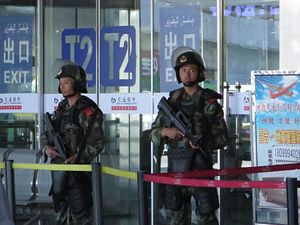The nature of terrorism in China is changing, as is the Chinese government’s response to the threat. Despite the importance of the issue for China and the world, there is little understanding in the West about the facts concerning terrorism in China. This is the first article in a four-part series dealing with the threat of terrorism in China — its origins and changing nature — as well as the central government’s response.
Beijing, Kunming, Urumqi: between 2013 and 2014, these three cities located in the northeast, south and west of China were the targets of major and extremely violent terrorist attacks. In less than eight months, 72 people died and 356 were injured in separate attacks using suicide car bombs, bladed weapons, and/or explosives (see the interactive map below for more details). While the international media did cover these events, there is still little knowledge in the West about the changing face of terrorism in China. Going beyond widespread preconceptions, it is necessary to identify the facts of the threat, its geographical expansion and transnational linkages, and how this issue shapes Chinese politics.
In recent years, China’s anti-terrorism policy has evolved rapidly from a rather reactive “defense against terror” to a proactive “war on terror,” along with permanent “crisis management.” Today, Beijing’s anti-terrorism efforts are becoming more comprehensive, sophisticated, and high-tech, with an unprecedented reach into affected regions and into society. As a domestic and transnational issue, terrorism is also a major priority for China’s international agenda, particularly its economic development strategy toward the West and its growing interests abroad. Beijing is likely to expand its international anti-terror efforts via bilateral cooperation and multilateral forums. In fact, China could become one of the major stake-holders in international efforts to combat terrorism.
The main terrorism threats in China originate from the Xinjiang Uyghur Autonomous Region in the northwest of the country. For roughly three decades, the region has been rocked by social unrest involving the indigenous populations — consisting mainly of Uyghurs and Han Chinese, the ethnic majority of the People’s Republic of China (PRC), but also of Tajiks, Kazakhs, Kyrgyz, Mongols, and Hui. Among the local groups opposing Beijing’s authority some more radical factions have emerged.
Xinjiang today is caught in a vicious circle. On the one hand, there are violent separatist and extremist groups among the Turkic-speaking Muslim Uyghurs, although the vast majority simply seek to freely practice their religion and customs. On the other hand, over the years Beijing has become more and more obsessed with stability. The central government has increasingly responded to social unrest with repression and has heightened the presence of its security apparatus in the region. This policy has alienated many Uyghurs from Beijing and nourished anti-Han Chinese sentiments among the Uyghur population.
The current tensions have a long history. Since China’s western expansion in the 18th century and the annexation of Xinjiang, the region and the central government have had a troubled relationship. The Uyghurs have long been fighting for the preservation of their culture against the perceived Han invasion. After a decade of resurgent expression of Uyghur culture and religion, 1989 marked a turning point for both Chinese authorities and the Uyghur population, as well as a new rise of separatist ideas. From Beijing’s perspective, the Tiananmen Square incident and the increasing local (student) protests reinforced the need for tighter control of the population and the crucial establishment of stability. From the Xinjiang separatists’ perspective, the defeat of the Soviet Union by the mujaheddin in Afghanistan was a source of hope and fueled radical Islamism in Xinjiang. Nevertheless, it is crucial to distinguish between the general Uyghur population (Uyghurs who are politically active in favour of more autonomy) and others who would go so far as to take part in terrorist activities.
Although Western countries have been very reticent to talk about terrorism in China, facts show that in recent years the PRC has been facing a genuine terrorism threat. However, it remains difficult to ascertain the nature and source of all alleged terror incidents that occur in Xinjiang. Very little official information is released and there are very few independent journalists on the ground. Moreover, information relayed by Chinese media and officials’ statements provide hardly any evidence or verifiable figures. It is therefore a fundamental challenge to differentiate between acts of social insurgency, state repression, and terrorism within the Xinjiang Uyghur Autonomous Region. In fact, the overall social and ethnic situation in China’s Western region blends into a broader conflict between Uyghurs and Han Chinese. The Heidelberg Institute for International Conflict Research even labeled the situation in Xinjiang a “limited war” in 2014.
Still, it is indisputable that major terrorist attacks have occurred recently in Xinjiang (Urumqi 2014) and elsewhere in China (Beijing 2013, Kunming 2014).
The current terrorist threat appears to be caused by scattered local unconnected groups rather than a single well-organized network with a clear chain of command. Yet the PRC government constantly blames the East Turkestan Islamic Movement as being behind most terrorist attacks and insurgencies. This organization, however, seems to have been replaced by the Turkestan Islamic Party, or partly absorbed into the Islamic Movement of Uzbekistan. The Turkestan Islamic Party did claim the attacks against buses in Shanghai and Kunming in 2008, as well as the Urumqi railway station attack in April 2014. The vast majority of the attacks, though, remain unclaimed by any organization.
Coming Thursday: The changing face of China’s terrorism threat.
Marc Julienne is a Visiting Academic Fellow at the Mercator Institute for China Studies (MERICS), Berlin. Moritz Rudolf and Johannes Buckow are Research Associates at MERICS.
































